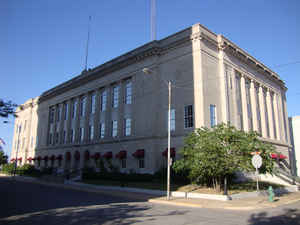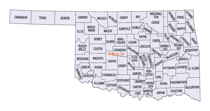Oklahoma Counties
There are seventy-seven counties in Oklahoma. Oklahoma originally had seven counties when it was first organized as the Oklahoma Territory. These counties were designated numerically, first through seventh. New counties added after this were designated by letters of the alphabet. The first seven counties were later renamed. The Oklahoma Constitutional Convention named all of the counties that were formed when Oklahoma entered statehood in 1907. Only two counties have been formed since thenMuskogee County, Oklahoma
Muskogee County Education, Geography, and History

Muskogee County is a county located in the state of Oklahoma. Based on the 2010 census, the population was 70,990. The county seat is
Muskogee. The county and city were named for the Muscogee (Creek) Nation. The official spelling of the name was changed to Muskogee by the
post office in 1900.
Muskogee County is part of the Muskogee, OK Micropolitan Statistical Area, which is included in the Tulsa-Muskogee-Bartlesville Combined
Statistical Area.
Etymology - Origin of Muskogee County Name
Named from the city, which in turn was named for the Muskogee or Creek tribe of Indians. The word is a corruption of "Maskoki" said to have been derived from an Algonquin word signifying swamp or marshy land.
Demographics:
County QuickFacts: CensusBureau Quick Facts
Muskogee County History
According to archaeological studies, prehistoric people lived in this area as long ago as the Paleo-Indian period
(before 6,000 B. C.). However, archaeologists have made more extensive studies of those people known as the Mound Builders who lived here
during the Caddoan Stage (A.D. 300 - 1200).
One of the first Europeans to come to this area was Jean Baptiste Bénard de la Harpe. He was a French explorer and trader who discovered a
Wichita village in 1719. By the end of the 18th century the Wichita had been driven away by the more warlike Osage, who used this as their
hunting ground. Auguste Pierre Chouteau and other fur traders had established a settlement at the Three Forks. Early in the 19th Century,
Cherokee and Choctaw hunting parties made incursions that caused frequent conflict with the Osage. In 1824, the US Army established Fort
Gibson on the Grand River to dampen the conflict. The town of Fort Gibson that grew up just outside the fort claims to be the oldest town in
Oklahoma.
At the start of the U. S. Civil War, Confederate troops of the Cherokee and Creek Home Guards built Fort Davis, across the Arkansas River from
Fort Gibson. Federal troops attacked and destroyed Fort Davis in 1862, driving the Confederates from this area, although a few skirmishes
occurred later in the war at Bayou Menard Skirmish (1862), several at Webbers Falls (1862), and the Creek Agency Skirmish (1863).
The county was formed at statehood with land from the Muskogee District of the Creek Nation and the Canadian and Illinois Districts of the
Cherokee Nation. A post office named Muscogee had been established January 17, 1872. The official spelling of the name was changed to Muskogee
on July 19, 1900.
Oklahoma History Center
Located in eastern Oklahoma, Muskogee County was named for the Muscogee (Creek) Tribe, although its boundaries
encompass the Muskogee District of the Creek Nation and a portion of the Illinois and Canadian districts of the Cherokee
Nation. This county is bordered by Wagoner and Cherokee counties on the north, Cherokee and Sequoyah counties on the
east, Haskell and McIntosh counties on the south, and Okmulgee and McIntosh counties on the west. The city of Muskogee,
established in 1872, serves as the county seat. In addition to Muskogee incorporated towns include Boynton, Braggs,
Council Hill, Fort Gibson, Haskell, Otkaha, Porum, Summit, Taft, Wainwright, Warner, and Webber Falls.
Three important rivers, the Arkansas, Verdigris, and Neosho (Grand), converge in Muskogee County. The county includes
838.99 square miles of land and water that encompass a varied topography. The western portion is primarily prairie
grassland growing over a layer of sandstone that contains pockets of coal, oil, and natural gas. The prairie gives way
to the wooded Cookson Hills in the county's eastern section, which is on the western fringe of the Ozark Mountains. The
confluence of the Arkansas, Verdigris, and Neosho gave the area the name of Three Forks, and several salt springs
attracted abundant game to the region....MUSKOGEE
COUNTY
Geography: Land and Water
As reported by the Census Bureau, the county has a total area of 840 square miles (2,200 km2), of which 810 square miles
(2,100 km2) is land and 29 square miles (75 km2) (3.5%) is water.
The western part of the county is prairie grassland, while the eastern part rises into the Cookson Hills, on the western edge of the Ozark
Mountains. The Arkansas, Verdigris and Grand rivers all converge in the county, causing that area to be called "Three Forks." Webbers Falls
Lake on the Arkansas River covers part of the county.
Neighboring Counties
Bordering counties are as follows:
- Wagoner County (north)
- Cherokee County (northeast)
- Sequoyah County (east)
- Haskell County (southeast)
- McIntosh County (southwest)
- Okmulgee County (west)
Education
Education was a high priority after the Civil War, with schools started by churches, private individuals, and the Cherokee and Creek nations. Higher educational opportunities were offered ater 1880 when Bacone College, Oklahoma's oldest, began as Indian University in Tahlequah, but was moved to the Creek Nation in present Muskogee County in 1885. Evangel Mission, a school at Union Agency for Creek freedmen, operated in the 1880s and now houses the Five Civilized Tribes Museum in Muskogee. A facility for educating visually impaired people opened at Fort Gibson in 1898. Later moved to Muskogee, it became the Oklahoma School for the Blind. Minerva Home, a school for girls in Muskogee, became Henry Kendall College in 1894, which moved to Tulsa and became the University of Tulsa in 1920. Northeastern State University opened a branch campus in Muskogee in 1994.







